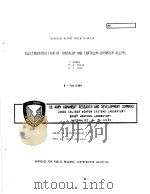《ELECTRODEPOSITION OF ALLOYS:PRINCIPLES AND PRACTICE VOLUME Ⅰ》
| 作者 | ABNER BRENNER 编者 |
|---|---|
| 出版 | ACADEMIC PRESS |
| 参考页数 | 714 |
| 出版时间 | 1963(求助前请核对) 目录预览 |
| ISBN号 | 无 — 求助条款 |
| PDF编号 | 813366968(仅供预览,未存储实际文件) |
| 求助格式 | 扫描PDF(若分多册发行,每次仅能受理1册) |

Part ⅠGENERAL AND PRACTICAL1
1.Survey of Alloy Plating3
1.1What Is ar Alloy?3
1.2 Definition of Powdered Alloys4
1.3 What Are Electrodeposited Alloys?5
1.4 Scope of Alloy Deposition5
1.5 Properties of Electrodeposited Alloys7
1.6 Present and Potential Uses of Alloy Deposits9
1.7 Potential Uses of the Alloy Plating Process10
References11
2.History and Literature of the Electrodeposition of Alloys12
2.1Invention of,and Early Interest in,Electroforming12
2.2 Birth of Modern Electroplating14
2.3 Alloy Plating before 190015
2.4 Alloy Plating since 190017
2.5 Literature of Alloy Deposition19
References19
3.Conductors,Current Flow,Electrode Potentials,and Definitions22
3.1Electrical Conductors22
3.2 Passage of Current from a Metallic Conductor to an Electrolyte24
3.3 Voltage25
3.4 Definitions of Electrical Terms26
3.5 Conventions Regarding Signs of Electrodes29
3.6 Static Potentials32
3.7 Synopsis of the Types of Alloy Plating Systems and the Six Principles of Alloy Deposition40
References42
4.Practical Considerations Involved in the Electrodeposition of Alloys44
4.1Introduction44
4.2 General Conditions for Electrodepositing Alloys45
4.3 Role of Static Potentials in the Electrodeposition of Alloys46
4.4 Role of Dynamic Potentials in the Electrodeposition of Alloys56
4.5 Replenishment of the Metal Content of Alloy Plating Baths59
4.6 Codeposition in Electrorefining71
References72
5.Variation in the Composition of Electrodeposited Alloys with the Composition of the Bath75
5.1General Discussion:Classification,Definitions,Procedures,Principles75
5.2 Examples of the Relation between the Composition of Electrodeposited Alloys and the Metal Ratio of the Bath80
5.3 Examples of the Relation between the Composition of Electrodeposited Alloys and the Total Metal Content of the Bath87
5.4 Relation between Composition of Electrodeposited Alloys and the Concentration of Complexing Agent in the Bath90
5.5 Effect of pH of the Plating Bath on the Composition of the Deposit96
5.6 Effect of Addition Agents on Composition of Electrodeposited Alloys103
5.7 Effect of Indifferent Salts on the Composition of the Electrodeposited Alloy105
5.8 Appendix:Special Topics Dealing with the Relation between the Metal Content of the Bath and the Composition of the Electrodeposited Alloy105
References119
6.Effect of Operating Variables on the Composition of Electrodeposited Alloys122
6.1Introduction122
6.2 Relation between Current Density and Composition of Electrodeposited Alloys122
6.3 Effect of Temperature on Composition of Electrodeposited Alloys139
6.4 Effect of Agitation of Bath or Rotation of Cathode on the Composition of Electrodeposited Alloys146
6.5 Relation between Alloy Composition and Some Miscellaneous or Composite Factors Involved in Plating149
6.6 Appendix:Experimental Arrangements for Studying Alloy Plating162
References172
7.Structure of Electrodeposited Alloys175
7.1Phase Diagrams of Alloys175
7.2 Microstructure of Electrodeposited Alloys175
7.3 Structure of Electrodeposited Alloys as Revealed bv X-Ray183
7.4 Effect of Plating Conditions on Structure of Electrodeposited Alloys198
7.5 Mechanism of Deposition on a Metallic Lattice201
7.6 Relation between Crystal Structure of Metals and Their Ease of Codeposition202
7.7 Effect of Heat Treatment on Phase Structure of Electrodeposited Alloys204
References205
8.Properties of Electrodeposited Alloys208
8.1Introduction208
8.2 Hardness209
8.3 Mechanical Properties:Tensile Strength,Ductility,and Young's Modulus218
8.4 Stress219
8.5 Density220
8.6 Electrical and Magnetic Properties222
8.7 Surface Appearance of Electrodeposited Alloys236
8.8 Heat Treatment of Alloys and Thermal Properties239
8.9 Chemical Reactivity of Electrodeposited Alloys243
8.10 Protective Value of Alloy Coatings245
8.11 Solderability of Electrodeposited Alloys247
8.12 Properties of Electrodeposited Alloys as Bearing Metals249
8.13 Inclusion Codeposits254
8.14 Cause of the Difference in the Properties of Electrodeposited and Metallurgical Alloys259
References260
Part ⅡTHEORY265
9.Theory of Electrodeposition of Alloys.General Considerations and Literature267
9.1Present Status267
9.2 What Should a Theory of Alloy Deposition Cover?267
9.3 Literature Survey of Theory of Alloy Deposition268
9.4 Outline of Theoretical Treatment of Alloy Deposition273
References274
10.The Cathode Diffusion Layer and Its Role in the Electrodeposition of a Single Metal276
10.1Introduction276
10.2 Diffusion Layer at Plane,Vertical Cathodes277
10.3 Experimental Methods of Studying the Diffusion Layer288
10.4 Equation for Material Balance at the Cathode in the Steady State297
References305
11.The Role of the Cathode Diffusion Layer in the Electrodeposition of Alloys307
11.1Introduction307
11.2 Equations of Material Balance and the Composition of Alloys307
11.3 Experimental Verification of Equations of Material Balance in Alloy Deposition311
11.4 Codeposition at the Limiting Current Density314
11.5 Codeposition When Transference Is the Controlling Factor325
11.6 Application of Diffusion Theory to Explain the Effects of Plating Variables on the Composition of Electrodeposited Alloys326
References329
12.Role of Cathode Potentials in the Electrodeposition of Alloys331
12.1Comparison of the Roles of Diffusion and of Cathode Potential.Mechanism of the Preferential Deposition of the More Noble Metal331
12.2 Relative Metal Ion Concentrations at the Cathode-Solution Interface333
12.3 Cathode Potentials and Abnormal Alloy Deposition337
12.4 Role of the Curves of Current Density vs.Cathode Potential in the Theory of Alloy Deposition339
12.5 Overvoltage of Alloy Deposition356
12.6 The Most NoblePotential at Which Codeposition Can Occur361
12.7 Shift of Potential in the Codeposition of Metals That Form Solid Solutions or Compounds362
12.8 Relation of the Composition of an Electrodeposited Alloy to the Deposition Potentials of the Alloy and of the Parent Metals367
12.9 Composition of Alloys Deposited at Constant Cathode Potential375
12.10 Relation Between Current Density-Potential Curves of Alloy Deposition and Phase Changes in the Deposit382
References385
13.Some Theoretical Aspects of Complexing Agents and Addition Agents in Alloy Plating388
13.1Scope of Discussion388
13.2 Discharge of Complex Metal Ions388
13.3 Static Electrode Potentials of Metals in Cyanide Solutions391
13.4 Relation between Diffusion Phenomena and the Effects of Complexing Agents398
13.5 Mechanism of the Effect of Addition Agents on the Composition of Electrodeposited Alloys402
References407
Part ⅢPRACTICAL CONSIDERATIONS AND SPECIFIC INFORMATION ON THE ELECTRODEPOSITION OF ALLOYS409
ALLOY GROUP A.SOME IMPORTANT ALLOYS OF COPPER AND SILVER411
14.Electrodeposition of Brass411
14.1Introduction411
14.2 Literature412
14.3 Electrodeposition of Brass from Cyanide Baths414
14.4 Electrodeposition of Brass from Noncyanide Plating Baths457
14.5 Deposition of Brass Coatings without an External Source of Current470
14.6 Structure of Electrodeposited Brass472
14.7 Properties475
14.8 Uses of Brass Plating476
14.9 Analysis of Brass Deposits and Brass Plating Solutions478
References486
15.Electrodeposition of Copper-Tin Alloys497
15.1General Survey497
15.2 Literature498
15.3 Electrodeposition of Copper-Tin Alloys from the Cyanide-Stannate Bath500
15.4 Other Cyanide-Containing Baths for Depositing Copper-Tin Alloys519
15.5 Noncyanide Baths for Depositing Copper-Tin Alloys522
15.6 Structure of Electrodeposited Copper-Tin Alloys528
15.7 Properties of Electrodeposited Copper-Tin Alloys532
15.8 Protective Value of Copper-Tin Coatings535
15.9 Uses of Electrodeposited Copper-Tin Alloys539
References540
16.Electrodeposition of Cadmium-Copper Alloys544
16.1Introduction544
16.2 Electrodeposition of the Alloys from Cyanide Baths544
16.3 Deposition of Cadmium-Copper Alloys from Noncyanide Baths553
16.4 Properties and Uses556
References557
17.Electrodeposition of Alloys Containing Copper and the Metals of the Iron Group558
17.1Introduction558
17.2 General Considerations concerning the Baths559
17.3 Electrodeposition of Copper-Nickel Alloys562
17.4 Electrodeposition of Copper-Iron Alloys574
17.5 Electrodeposition of Copper-Cobalt Alloys576
17.6 Electrodeposition of Copper-Iron-Nickel Alloys576
References583
18.Electrodeposition of Brass-or Bronzelike Ternary Alloys585
18.1Introduction585
18.2 Electrodeposition of Copper-Tin-Zinc Alloys585
18.3 Electrodeposition of Copper-Cadmium-Zinc Alloys590
18.4 Electrodeposition of Copper-Cadmium-Tin Alloys597
18.5 Copper-Nickel-Zinc Alloys597
18.6 Electrodeposition of Copper-Nickel-Tin Alloy606
18.7 Electrodeposition of Copper-Cobalt-Tin Alloy606
18.8 Electrodeposition of Copper-Antimony-Zinc Alloys606
References607
19.Electrodeposition of Copper-Silver Alloys and Some Miscellaneous Alloys of Silver609
19.1Introduction609
19.2 Electrodeposition of Copper-Silver Alloys609
19.3 Electrodeposition of Silver-Tin Alloys615
19.4 Electrodeposition of Silver Alloys of the Iron-Group Metals615
19.5 Codeposition of Silver with the Platinum Metals619
References625
20.Electrodeposition of Copper-Lead and Silver-Lead Alloys627
20.1Introduction627
20.2 Electrodeposition of Copper-Lead and Silver-Lead Alloys from Alkaline Baths628
20.3 Electrodeposition of Copper-and Silver-Lead Alloys from Acid or Neutral Solutions644
20.4 Structure and Properties of Electrodeposited Copper-and Silver-Lead Alloys649
References656
21.Electrodeposition of Silver-Cadmium and Silver-Zinc Alloys658
21.1Introduction and Literature Survey658
21.2 Electrodeposition of Silver-Cadmium Alloys659
21.3 Electrodeposition of Silver-Zinc Alloys668
21.4 Structure of Electrodeposited Silver-Cadmium and Silver-Zinc Alloys671
21.5 Properties of Electrodeposited Silver-Cadmium Alloys674
21.6 Uses of Electrodeposited Silver-Cadmium and Silver-Zinc Alloys676
21.7 Electrodeposition of Silver-Zinc-Gold and Silver-Zinc-Palladium Alloys677
References677
AUTHOR INDEX679
SUBJECT INDEX691
1963《ELECTRODEPOSITION OF ALLOYS:PRINCIPLES AND PRACTICE VOLUME Ⅰ》由于是年代较久的资料都绝版了,几乎不可能购买到实物。如果大家为了学习确实需要,可向博主求助其电子版PDF文件(由ABNER BRENNER 1963 ACADEMIC PRESS 出版的版本) 。对合法合规的求助,我会当即受理并将下载地址发送给你。
高度相关资料
-
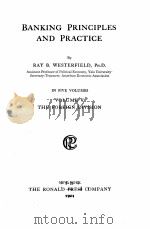
- BANKING PRINCIPLES AND PRACTICE VOLUME 5
- 1921 THE RONALD PRESS COMPANY
-

- THE PRINCIPLES AND PRACTICE OF PRESTRESSED CONCRETE VOLUME 1
- 1952 COPYRIGHT
-
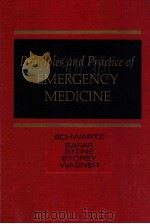
- PRINCIPLES AND PRACTICE OF EMERGENCY MEDICINE VOLUME Ⅱ
- 1978 W.B. SAUNDERS COMPANY
-

- PRINCIPLES AND PRACTICE OF OBSTETRICS & PERINATOLOGY VOLUME 1
- 1981 JOHN WILEY & SONS
-

- PRINCIPLES AND PRACTICE OF OBSTETRICS & PERINATOLOGY VOLUME 2
- 1981 JOHN WILEY & SONS
-

- ELECTRODEPOSITION OF ALLOYS:PRINCIPLES AND PRACTICE VOLUME Ⅱ
- 1963 ACADEMIC PRESS
-

- ELECTRODEPOSITION OF ALLOYS:PRINCIPLES AND PRACTICE VOLUME Ⅰ
- 1963 ACADEMIC PRESS
-
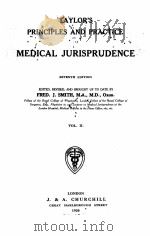
- TAYLOR‘S PRINCIPLES AND PRACTICE OF MEDICAL JURISPRUDENCE VOLUME II
- 1920 J. AND A. CHURCHILL
-
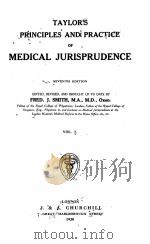
- TAYLOR‘S PRINCIPLES AND PRACTICE OF MEDICAL JURISPRUDENCE VOLUME I
- 1920 J. AND A. CHURCHILL
-
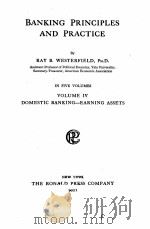
- BANKING PRINCIPLES AND PRACTICE VOLUME 4
- 1921 THE RONALD PRESS COMPANY
-

- BANKING PRINCIPLES AND PRACTICE VOLUME 3
- 1921 THE RONALD PRESS COMPANY
提示:百度云已更名为百度网盘(百度盘),天翼云盘、微盘下载地址……暂未提供。➥ PDF文字可复制化或转WORD


